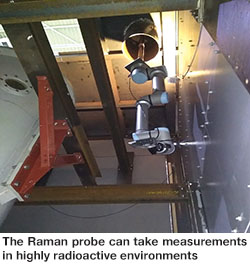Jacobs deploys scientific breakthrough in radioactive and hazardous substance contamination monitoring
05/10/2020
Jacobs is deploying a new type of Raman spectroscopy technology, which makes it safer and cheaper to spot radioactive contamination or other hazardous substances in waste stores and nuclear facilities undergoing decommissioning.Raman spectroscopy1, which works by firing lasers at a target and measuring the resulting molecular vibrations, is one of the most effective techniques for identifying specific chemical compounds. However, it is rarely used in nuclear decommissioning, where access constraints and high-radiation fields can prevent the spectrometer from working at its typical effective range.
 A team from Jacobs and IS Instruments, based in Kent, UK, have designed a new type of Raman system that can still detect a weak laser signal when positioned several metres from the target. In addition, the team has found a way to mount the Raman probe onto either a remotely operated vehicle or robot arm. This enables the probe to get within two metres of the target and send a signal down an optical cable to the main Raman instrument, safely positioned tens of metres away.
A team from Jacobs and IS Instruments, based in Kent, UK, have designed a new type of Raman system that can still detect a weak laser signal when positioned several metres from the target. In addition, the team has found a way to mount the Raman probe onto either a remotely operated vehicle or robot arm. This enables the probe to get within two metres of the target and send a signal down an optical cable to the main Raman instrument, safely positioned tens of metres away.“Standard equipment often cannot detect specific chemical agents, either because it cannot get close enough or because the signals are crowded out by the overall radiation levels,” said Clive White, Jacobs Critical Mission Solutions International Senior Vice President. “This new type of Raman system is an important breakthrough for the nuclear industry because it provides greater certainty about the presence of hazardous materials in high-radiation waste facilities, making the materials easier, cheaper and safer to detect.”
Jacobs and Innovate UK, a UK government agency, have provided funding to take the system from proof-of-concept to commercial application. It is now being used to detect uranium and also substances such as kerosene and tributyl phosphate, which are used in reprocessing operations and can indicate the presence of plutonium or uranium contamination.
Legacy nuclear facilities sometimes contain significant amounts of poorly identified or unknown waste materials, so an improved characterisation capability can reduce decommissioning costs and timescales.
Raman technology is also a key feature of a new integrated decommissioning system built by Jacobs, which won a recent UK government-funded innovation competition and will be demonstrated inside highly radioactive former fuel reprocessing facilities at Sellafield later this year.
Outside of the nuclear sector, this advance in Raman technology will be a valuable tool in areas where human access is impossible or problematic.
www.jacobs.com
1https://is-instruments.com/background-science/what-is-raman-spectroscopy